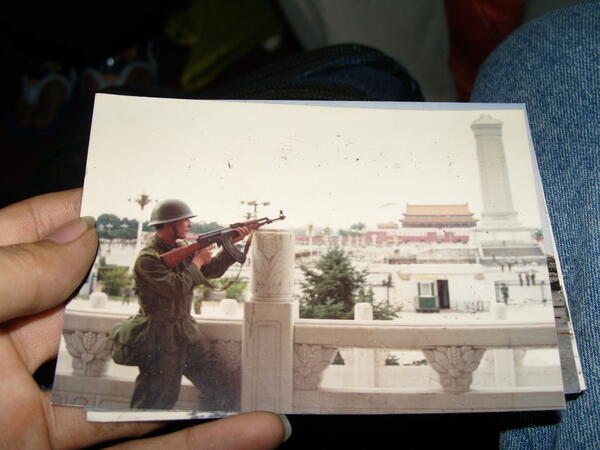New photos emerge of Tiananmen Square just after 1989 massacre
Monday marks the 23rd anniversary of the brutal crackdown on student protesters in Tiananmen Square, Beijing. Since then, the Chinese government has done everything in its power to . By chance, a Chinese blogger got his hands on photos of the square taken by a soldier the day after the incident. Chinese authorities are now trying to censor these photos.
Issued on: Modified:

Soldiers burn what appears to be the remnants of the protesters' camp in Tiananmen Square. Photo taken on June 5, 1989.
Monday marks the 23rd anniversary of the brutal crackdown on student protesters in Tiananmen Square, Beijing. Since then, the Chinese government has done everything in its power to erase all traces of the massacre. By chance, a Chinese blogger got his hands on photos of the square taken by a soldier the day after the incident. Chinese authorities are now trying to censor these photos.

A soldier near Tiananmen Square on June 5, 1989.

'The woman who had these photos didn't realise their importance. I did.'
Zuola is a blogger and activist from mainland China who currently lives in Taipei, Taiwan.
In 2007, I met a woman on a train, and we started talking about Tiananmen. She showed me her family’s photo album. Her husband, a soldier, was sent to Tiananmen in 1989. He took these photos on June 5, 1989, the day after the massacre. She didn’t tell me much more than that. I think she didn’t realise that what were just a few snapshots in a family album to her was is proof for many others of the violence that took place on that fateful day. I realized how important this was, so I asked her if she would give me her photos. She refused, so instead I took pictures of them.
She told me that many soldiers who had participated in the massacre were never given public sector jobs, as was generally the tradition in this communist system. I imagine the authorities were very worried that after what they had seen and done, these soldiers might actually end up defending democracy.
"Thirty minutes after I posted the photos on Weibo, the site deleted them"
I published these photos for the first time in 2009 on Twitter [which is impossible to access in China without using a proxy server] on the occasion of the massacre’s 20th anniversary. At the time, only a few people noticed them. This year, I reposted them on Flickr and Twitpic, and now lots of people are talking about them. Social networks work in mysterious ways!
I also posted them on Sina Weibo [the Chinese equivalent of Twitter] yesterday. Many users immediately reposted them. But 30 minutes later, the site deleted all the posts.
The government’s propaganda has managed to convince many people that nothing happened at Tiananmen. By publishing these photos, I wanted to prove that a bloody crackdown indeed took place on June 4, 1989.

Three soldiers posing in Tiananmen Square, in front of the Forbidden City, on June 5, 1989.
The Tiananmen Square massacre and its legacy
In mid-April 1989, Chinese students launched a movement calling for democratic reforms and an end to nepotism and corruption. They were soon joined by more protesters from all walks of life, and set up camp in and around Tiananmen Square, in the centre of the capital. After nearly two months of protest, on June 4, 1989, the Chinese government sent the army to quash the movement. For several hours, soldiers clashed with the protesters, who set up barricades in the streets leading to the square. Several witnesses say they saw gunfire. During the night, tanks moved in on the square, crushing everything in their way, including protesters.
To this day, the exact number of people killed that night remains unknown. According to the Chinese government, several hundred people died, including soldiers.
The Chinese authorities censor all information relating to this incident. Typing “Tiananmen” on Chinese search engines only turns up a slideshow of postcard-like photos of the square. In addition, the authorities do not allow any commemorations of this event. Each year, as June 4 approaches, they ramp up security on the ground and online (key words like “four six” and “candle” are currently censored on microblogging site Sina Weibo).
In Hong Kong, however, several thousand people are expected to attend a memorial service honouring those killed in 1989. The event’s organisers have created a Goddess of Democracy, a replica of the statue that the Tiananmen Square protesters had set up just before the army attacked.